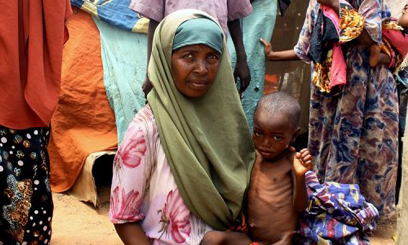“No more region in Somalia is under famine conditions,” Jose Graziano da Silva, the head of the UN’s Food and Agriculture Organisation (FAO), told reporters. “However, the good news does not mean the crisis is over.”
Three areas had been in famine: southern Somalia’s Middle Shabelle, in Afgoye — the world’s largest camp for displaced people — and inside camps in the anarchic capital Mogadishu.
However, those areas “have now improved to emergency level,” the UN said, while warning that the situation remains critical.
“If we do not continue to support these people…these people will not survive and we will have famine back,” the UN food agency chief said.
At least 2.34 million people or about a third of the country still need support across Somalia, while hunger will increase in the lean period before next harvest.
“We have less than 100 days to avoid a new famine in the region,” he said.
Famine was first declared in Somalia’s Southern Bakool and Lower Shabelle regions in July, but later spread to other areas. Three areas improved to emergency levels last November.
“The combination of the massive scale-up in humanitarian assistance and an exceptional harvest have helped to improve the humanitarian situation,” a UN statement read.
Somalia, ravaged by nearly uninterrupted civil war for the past two decades, is one of the most dangerous places in the world for aid workers and one of the regions that needs them most.
“The gains are fragile and will be reversed without continued support,” said Mark Bowden, the UN Humanitarian Coordinator for Somalia.
“There are 1.7 million people in southern Somalia still in crisis. Millions of people still need food, clean water, shelter and other assistance to survive and the situation is expected to deteriorate in May,” Bowden added.
Much of southern Somalia is controlled by Al-Qaeda linked Shebab fighters, who have imposed draconian restrictions on aid agencies wanting to support those struggling in the war-wracked region.
The hardline Shebab are facing increasing pressure from government forces and regional armies, with Kenyan forces in the south, Ethiopia’s army in the south and west, and the African Union troops in Mogadishu.
“The world shouldn’t turn its back on Somalia, solely because statistics say there is no longer a famine,” Senait Gebregzhiabher, the head of Oxfam in Somalia, said in a statement.
“We are seeing improvements in Somalia due to a good harvest and effective humanitarian aid, but the fear is that conflict threatens to jeopardize these gains.”
Famine implies that at least a fifth of households face extreme food shortages, with acute malnutrition in over 30 percent of people, and two deaths per 10,000 people every day, according to the UN definition.









































